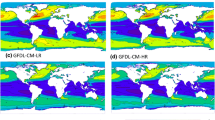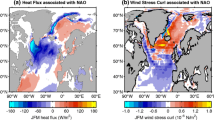Abstract
Analyses indicate that the Atlantic Ocean seasurface temperature (SST) was considerably colder at the beginning than in the middle of the century. In parallel, a systematic change in the North Atlantic sea-level pressure (SLP) pattern was observed. To find out whether the SST and SLP changes analyzed are consistent, which would indicate that the SST change was real and not an instrumental artifact, a response experiment with a low-resolution (T21) atmospheric GCM was performed. Two perpetual January simulations were conducted, which differ solely in the Atlantic Ocean (40° S-60° N) SST: the “cold” simulation utilizes the SSTs for the period 1904–1913; the “warm” simulation uses the SSTs for the period 1951–1960. Also, a “control” run with the model's standard SST somewhat between the “cold” and “warm” SST was made. For the response analysis, a rigorous statistical approach was taken. First, the null hypothesis of identical horizontal distributions was subjected to a multivariate significance test. Second, the level of recurrence was estimated. The multivariate statistical approaches are based on hierarchies of test models. We examined three different hierarchies: a scale-dependent hierarchy based on spherical harmonics (S), and two physically motivated ones, one based on the barotropic normal modes of the mean 300 hPa flow (B) and one based on the eigenmodes of the advection diffusion operator at 1000 hPa (A). The intercomparison of the “cold” and “warm” experiments indicates a signal in the geostrophic stream function that in the S-hierarchy is significantly nonzero and highly recurrent. In the A-hierarchy, the low level temperature field is identified as being significantly and recurrently affected by the altered SST distribution. The SLP signal is reasonably similar to the SLP change observed. Unexpectedly, the upper level stream-function signal does not appear to be significantly nonzero in the B-hierarchy. If, however, the pairs of experiments “warm versus control” and “cold versus control” are examined in the B-hierarchy, a highly significant and recurrent signal emerges. We conclude that the “cold versus warm” response is not a “small disturbance” that would allow the signal to be described by eigenmodes of the linear system. An analysis of the three-dimensional structure of the signal leads to the hypothesis that two different mechanisms are acting to modify the model's mean state. At low levels, local heating and advection are dominant, but at upper levels the extratropical signal is a remote responce to modifications of the tropical convection.
Similar content being viewed by others
References
Alexander RC, Mobley RL (1976) Monthly average sea-surface temperatures and ice-pack limits on a 1° global grid. Mon Weather Rev 104:143–148
Barnett TP, Preisendorfer RW, Goldstein LM, Hasselmann K (1981) Significance tests for regression model hierarchies. J Phys Oceanogr 11:1150–1154
Barnett TP, Heinz HD, Hasselmann K (1984) Statistical prediction of seasonal air temperatures over Eurasia. Tellus 36A:132–146
Branstator G (1985a) Analysis of general circulation model sea-surface temperature anomaly simulations using a linear model. Part I. Forced solutions. J Atmos Sci 42:2225–2241
Branstator G (1985b) Analysis of general circulation model seasurface temperature anomaly simulations using a linear model. Part II. Eigenanalysis. J Atmos Sci 42:2242–2254
Chervin RM, Kutzbach JE, Houghton DD, Gallimore RG (1989) Response of the NCAR general circulation model to prescribed changes in ocean surface temperature. Part II. Midlatitude and subtropical changes. J Atmos Sci 37:308–322
Egger J (1977) On the linear theory of the atmospheric response to sea surface temperature anomalies. J Atmos Sci 34:603–614
Fischer G (ed) (1987) Climate simulations with the ECMWF T21 Model in Hamburg. Meteorologisches Institut der Unversität Hamburg. Large Scale Atmospheric Modelling Report 1
Folland CK, Palmer TN, Parker DE (1986) Sahel rainfall and worldwide sea temperatures 1901–85. Nature 320:602–607
Frankignoul C, Molin A (1988a) Response of the GISS general circulation model to a midlatitude sea surface temperature anomaly in the North Pacific. J Atmos Sci 45:95–108
Frankignoul C, Molin A (1988b) Analysis of the GISS GCM response to a subtropical sea surface temperature anomaly using a linear model. J Atmos Sci 45:3833–3845
Glowienka R (1985) Studies on the variability of Icelandic low and Azores high between 1881 and 1982. Beitr Phys Atmos 58:160–170
Glowienka-Hense R (1988) Performance of the ECMWF T21 model in simulating the North Atlantic oscillation (NAO). Climate simulations with the ECMWF T21-model in Hamburg, Part II. In: Storch H von (ed) Meteorologisches Institut der Universität Hamburg Large Scale Atmospheric Modelling Report 4:35–51
HannoschÖck G, Frankignoul C (1985) Multivariate statistical analysis of a sea surface temperature anomaly experiment with the GISS general circulation model. J Atmos Sci 42:1430–1450
Hasselmann K (1979) On the signal- to-noise problem in atmospheric response studies. Meteorology over the tropical oceans. R Met Soc London, pp 251–259
Held I, Kang I-S (1987) Barotropic models of the extratropical response to El Niño. J Atmos Sci 44:1433–1452
Hense A (1986) Multivariate statistical analysis of the Northern Hemisphere circulation during the El Niño 1982/83. Tellus 38A:189–204
Höflich W (1974) The seasonal and secular variations of the meteorological parameters on both sides of the ITCZ in the Atlantic ocean. GARP Report 2
Jones PD, Raper SCB, Sauter BS, Cherry BSG, Goodess C, Bradley RS, Diaz HF, Kelly PM, Wigley TML (1985) A gridpoint surface air temperature data set for the Northern Hemisphere, 1851–1984. -DoE technical Report No. 22 US Department of Energy Carbon Dioxide Research Division, Washington DC, 251 pp
Lautenschlager M, Schlese U, Ponater M, Mai W, Ulbrich U, Speth P (1988) Atmospheric response to Ice Age January conditions. Climate Simulations with the ECMWF T21-model in Hamburg, Part 11, H v Storch (ed) Meteorologisches Institut der Universität Hamburg Large Scale Atmospheric Modelling Report 4:191–230
Loon van H, Rogers J (1978) The seesaw in winter temperature between Greenland and northern Europe. Part I: General description. Mon Weather Rev 106:296–310
Loon van H, Madden RA (1983) Interannual variations of monthly mean sea-level pressure in January. J Climate Appl Met 22:687–692
Navarra A, Miyakoda K (1988) Anomaly general circulation models. J Atmos Sci 45:1509–1530
Okamoto M (1963) An asymptotic expansion for the distribution of the linear discriminant function. Ann Math Stat 34:1286–1301
Page JT (1985) Error rate estimation in discriminant analysis. Technometrics 27:189–198
Palmer TN, Sun Zhaobao (1985) A modelling and observational study of the relationship between sea surface temperature in the north-west Atlantic and the atmospheric general circulation. Quart J R Met Soc 111:947–975
Pitcher EJ, Blackmon ML, Bates GT, Munoz S (1988) The effect of North Pacific sea surface temperature anomalies on the January climate of a general circulation model. J Atmos Sci 45:173–188
Rogers JC (1985) Atmospheric circulation changes associated with the warming over the northern North Atlantic in the 1920s. J Climate Appl Met 24:1303–1310
Rowntree, PR (1979) The effects of changes in ocean temperatures on the atmosphere. Dyn Atmosph Oceans 3:373–390
Sardeshmukh P, Hoskins BJ (1988) The generation of global rotational flow by steady idealized tropical divergence. J Atmos Sci 45:1228–1252
Schneider EK (1988) A formulation for diagnostic anomaly models. Pageoph 126:137–140
Simmons AJ, Wallace JM, Branstator G (1983) Barotropic wavepropagation and instability, and atmospheric teleconnection patterns. J Atmos Sci 40:1363–1392
Storch H von, Kruse H (1985) The extratropical atmospheric response to El Niño events. Tellus 37a:361–377
Storch H von (1987) A statistical comparison with observations of control and El Niño simulations using the NCAR CCM. Beitr Phys Atmosph 60:464–477
Storch H von, Zwiers F (1988) Recurrence analysis of Climate sensitivity experiments. J Climat 1:157–171
Storch H von (ed) (1988) Climate simulations with the ECMWF T21-Model in Hamburg Part II: Climatology and sensitivity experiments. Meteorologisches Institut der Universität Hamburg Large Scale Atmospheric Modelling Report 4:265 pp
Webster PJ (1981) Mechanism determining the atmospheric response to sea surface temperature anomalies. J Atmos Sci 38:554–571
Zwiers F, Boer GJ (1987) A comparison of climates simulated by a general circulation model when run in the annual cycle and perpetual modes. Mon Wea Rev 115:2626–2644
Zwiers F, Storch H von (1989) Multivariate Recurrence Analysis. J Climat 2:1538–1553
Author information
Authors and Affiliations
Additional information
This paper was presented at the International Conference on Modelling of Global Climate Change and Variability, held in Hamburg 11–15 September 1989 under the auspices of the Meteorological Institute of the University of Hamburg and the Max Planck Institute for Meteorology. Guest Editor for these papers is Dr. L. Dilmenil.
AWI Publication no. 254
Rights and permissions
About this article
Cite this article
Hense, A., Glowienka-Hense, R., von Storch, H. et al. Northern hemisphere atmospheric response to changes of atlantic ocean SST on decadal time scales: a GCM experiment. Climate Dynamics 4, 157–174 (1990). https://doi.org/10.1007/BF00209519
Received:
Accepted:
Issue Date:
DOI: https://doi.org/10.1007/BF00209519




